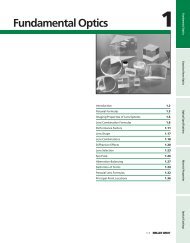Intel PXA250 and PXA210 Applications Processors
Intel PXA250 and PXA210 Applications Processors
Intel PXA250 and PXA210 Applications Processors
Create successful ePaper yourself
Turn your PDF publications into a flip-book with our unique Google optimized e-Paper software.
Contents<br />
Contents<br />
1 Introduction.................................................................................................................................1-1<br />
1.1 Functional Overview ..........................................................................................................1-1<br />
1.2 Package Information..........................................................................................................1-2<br />
1.2.1 Package Introduction ............................................................................................1-2<br />
1.2.2 Signal Pin Descriptions.........................................................................................1-4<br />
2 System Memory Interface ..........................................................................................................2-1<br />
2.1 Overview............................................................................................................................2-1<br />
2.2 SDRAM Interface...............................................................................................................2-3<br />
2.3 SDRAM memory wiring diagram .......................................................................................2-3<br />
2.4 SDRAM Support ................................................................................................................2-5<br />
2.5 SDRAM Address Mapping.................................................................................................2-6<br />
2.6 Static Memory....................................................................................................................2-7<br />
2.6.1 Overview...............................................................................................................2-7<br />
2.6.2 Boot Time Defaults ...............................................................................................2-8<br />
2.6.3 SRAM / ROM / Flash / Synchronous Fast Flash Memory Options .......................2-9<br />
2.6.4 Variable Latency I/O Interface Overview ..............................................................2-9<br />
2.6.5 External Logic for PCMCIA Implementation .......................................................2-11<br />
2.6.6 DMA / Companion Chip Interface .......................................................................2-14<br />
2.7 System Memory Layout Guidelines .................................................................................2-17<br />
2.7.1 System Memory Topologies (Min <strong>and</strong> Max Simulated Loading).........................2-17<br />
2.7.2 System Memory Recommended Trace Lengths.................................................2-18<br />
3 LCD Display Controller ..............................................................................................................3-1<br />
3.1 LCD Display Overview.......................................................................................................3-1<br />
3.2 Passive (DSTN) Displays ..................................................................................................3-1<br />
3.2.1 Typical Connections for Passive Panel Displays..................................................3-2<br />
3.2.1.1 Passive Monochrome Single Panel Displays........................................3-2<br />
3.2.1.2 Passive Monochrome Single Panel Displays, Double-Pixel Data.........3-3<br />
3.2.1.3 Passive Monochrome Dual Panel Displays ..........................................3-3<br />
3.2.1.4 Passive Color Single Panel Displays ....................................................3-4<br />
3.2.1.5 Passive Color Dual Panel Displays.......................................................3-4<br />
3.3 Active (TFT) Displays ........................................................................................................3-5<br />
3.3.1 Typical connections for Active Panel Displays......................................................3-6<br />
3.4 <strong>PXA250</strong> Pinout ..................................................................................................................3-7<br />
3.5 Additional Design Considerations......................................................................................3-8<br />
3.5.1 Contrast Voltage ...................................................................................................3-8<br />
3.5.2 Backlight Inverter ..................................................................................................3-8<br />
3.5.3 Signal Routing <strong>and</strong> Buffering ................................................................................3-8<br />
3.5.4 Panel Connector ...................................................................................................3-9<br />
4 USB Interface ..............................................................................................................................4-1<br />
4.1 Self Powered Device .........................................................................................................4-1<br />
4.1.1 Operation if GPIOn <strong>and</strong> GPIOx are Different Pins................................................4-1<br />
4.1.2 Operation if GPIOn <strong>and</strong> GPIOx are the Same Pin................................................4-2<br />
4.2 Bus Powered Device .........................................................................................................4-2<br />
<strong>PXA250</strong> <strong>and</strong> <strong>PXA210</strong> <strong>Applications</strong> <strong>Processors</strong> Design Guide<br />
iii
















